Boardsports are active outdoor sports that are played with some sort of board as the primary equipment. These sports take place on a variety of terrains, from paved flat-ground and snow-covered hills to water and air. Most boardsports are considered action sports or extreme sports, and thus often appeal to youth. Some board sports were marginalized in the past. However, many board sports are gaining mainstream recognition, and with this recognition, they have enjoyed wider broadcast, sponsorship and inclusion in institutional sporting events, including the Olympic Games.
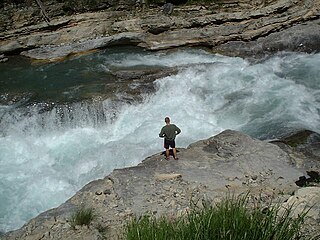
Whitewater forms in a rapid context, in particular, when a river's gradient changes enough to generate so much turbulence that air is trapped within the water. This forms an unstable current that froths, making the water appear opaque and white.

A surfboard is a narrow plank used in surfing. Surfboards are relatively light, but are strong enough to support an individual standing on them while riding an ocean wave. They were invented in ancient Hawaii, where they were known as papa he'e nalu in the Hawaiian language, and were usually made of wood from local trees, such as koa. They were often over 460 cm (15 ft) in length and extremely heavy. Major advances over the years include the addition of one or more fins (skegs) on the bottom rear of the board to improve directional stability, and numerous improvements in materials and shape.

Whitewater kayaking is an adventure sport where a river is navigated in a decked kayak. Whitewater kayaking includes several styles. River running; where the paddler follows a river and paddles rapids as they travel. Creeking usually involving smaller, steeper, and more technical waterways. Creek boats tend to be short but high volume to allow for manoeuvrability while maintaining buoyancy. Slalom requires paddlers to navigate through "gates". Slalom is the only whitewater event to be in the Olympics. Play boating involves staying on one feature of the river and is more artistic than the others. Squirt boating uses low-volume boats to perform special moves in whitewater features.

The Clutha River is the second longest river in New Zealand and the longest in the South Island. It flows south-southeast 338 kilometres (210 mi) through Central and South Otago from Lake Wānaka in the Southern Alps to the Pacific Ocean, 75 kilometres (47 mi) south west of Dunedin. It is the highest volume river in New Zealand, and the swiftest, with a catchment of 21,960 square kilometres (8,480 sq mi), discharging a mean flow of 614 cubic metres per second (21,700 cu ft/s). The river is known for its scenery, gold-rush history, and swift turquoise waters. A river conservation group, the Clutha Mata-Au River Parkway Group, is working to establish a regional river parkway, with a trail, along the entire river corridor.

Skimboarding or skimming is a boardsport in which a skimboard is used to glide across the water's surface to meet an incoming breaking wave, and ride it back to shore. There are currently 3 U.S. based competitive organizations including Premier Skim, Skim USA, and the United Skim Tour. Wave-riding skimboarders perform a variety of surface and air maneuvers, at various stages of their ride, out to, and back with, the wave. Some of these are known as "wraps", "big spins", "360 shove-its" and "180s". Unlike surfing, skimboarding begins on the beach by dropping the board onto the thin wash of previous waves. Skimboarders use their momentum to skim out to breaking waves, which they then catch back into shore in a manner similar to surfing.
Raging Waters are a chain of three water theme parks in San Dimas, California, San Jose, California, and Sydney, Australia. The parks are operated by Palace Entertainment and owned by its parent company Parques Reunidos, but they each contain different attractions. The parks are generally closed during the winter months.

The Kawarau River is a river in the South Island of New Zealand. It drains Lake Wakatipu in northwestern Otago via the lake's Frankton Arm. The river flows generally eastwards for about 60 kilometres (37 mi) and passes through the steep Kawarau Gorge until it joins Lake Dunstan near Cromwell. Before the construction of the Clyde High Dam, the Kawarau joined the Clutha River / Mata-Au in a spectacular confluence at Cromwell. The Shotover River enters the Kawarau from the north; the Nevis River enters it from the south. With many rapids and strong currents, the river can be dangerous and has claimed many lives. It is popular for bungy jumping and kayaking.
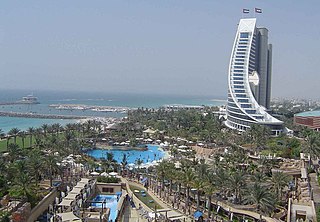
The Wild Wadi Water Park is an outdoor water park in Dubai, United Arab Emirates. Situated in the area of Jumeirah, next to the Burj Al Arab and the Jumeirah Beach Hotel, the water park is operated by Jumeirah International, a Dubai-based hotelier.

Disney's Typhoon Lagoon is a water theme park located at the Walt Disney World Resort in Lake Buena Vista, Florida near Orlando, and is one of two operating water parks at the resort. It is the second water park to open at the resort, preceded by Disney's River Country which closed in November 2001.
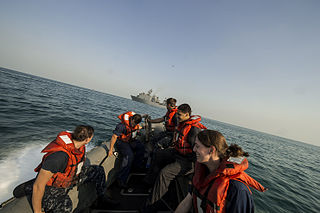
A personal flotation device is a flotation device in the form of a vest or suit that is worn by a user to prevent the wearer from drowning in a body of water. The device will keep the wearer afloat with their head and mouth above the surface – they do not have to swim or tread water in order to stay afloat and can even be unconscious.
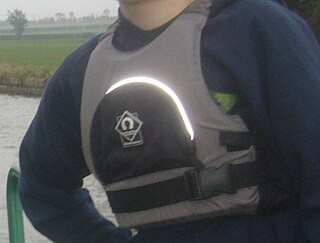
Buoyancy aids are a specialist form of personal flotation device (PFD) used most commonly by kayakers, canoeists, people practicing rafting, and dinghy sailors. They are designed as a flotation aid, rather than merely a life-saving device and have several key differences to other PFD's and lifejackets. Some buoyancy aids may not provide the same high level of protection as lifejackets.

River surfing is the sport of surfing either standing waves, tidal bores or upstream waves in rivers. Claims for its origins include a 1955 ride of 2.4 km (1.5 mi) along the tidal bore of the River Severn.
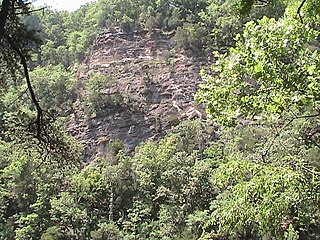
The Bee Cliff is a prominent northeast Tennessee geological limestone feature with high caves that overlooks the Watauga River and the Siam community of Carter County, Tennessee.
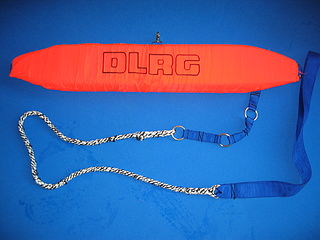
A rescue buoy or rescue tube or torpedo buoy is a piece of lifesaving equipment used in water rescue. This flotation device can help support the victim's and rescuer's weight to make a rescue easier. It is an essential part of the equipment that must be carried by lifeguards. It further can act as a mark of identification, identifying an individual as a lifeguard.

Standup paddleboarding (SUP) is a water sport born from surfing with modern roots in Hawaii. Standup paddleboarders stand on boards that are floating on the water, and use a paddle to propel themselves through the water. The sport was documented in a 2013 report that identified it as the outdoor sporting activity with the most first-time participants in the United States that year. Variations include flat water paddling, racing, surfing, whitewater SUP, yoga, and fishing.

Roman Rapids is a white-water river rapids ride located in Festa Italia of Busch Gardens Williamsburg, Virginia. It is themed after a canal race through Roman ruins and leaves riders fully soaked after the ride.
Horse surfing is an extreme sport invented in 2005. It requires two people, a horse, and a board. Horse surfing involves one person riding either a kite-board, surfboard, wake-board, or skim-board, while being towed behind a horse, ridden by a second person, through shallow water, at speeds up to 40 miles per hour (64 km/h). After originating in England the first official horse surfing competition was held in 2006 in La Baule, France, and over the last 14 years the sport has continued to spread internationally. Today there are several international competitions with globally established rules and categories.
















